#Geostationary orbit
Text
24 hours on Earth as seen from geostationary orbit — captured by a weather satellite. 🌏🕰️
—
A geostationary orbit, also referred to as a geosynchronous equatorial orbit (GEO), is a circular geosynchronous orbit 35,786 km (22,236 mi) in altitude above Earth's equator, 42,164 km (26,199 mi) in radius from Earth's center, and following the direction of Earth's rotation.
2 notes
·
View notes
Text
WATCH SPACEX LAUNCH TODAY AT 11:04 pm EST ~ There is More to This Life
SpaceX’s powerful Falcon Heavy rocket will launch for the seventh time ever today, Thursday (July 27), and you can watch the epic action live, according to Mike Wall in a Space.com article posted yesterday.
The Falcon Heavy is scheduled to lift off Thursday at 11:04 p.m. EDT (0304 GMT on July 27) from Pad 39A at NASA’s Kennedy Space Center in Florida. You can watch it live here at Space.com,…
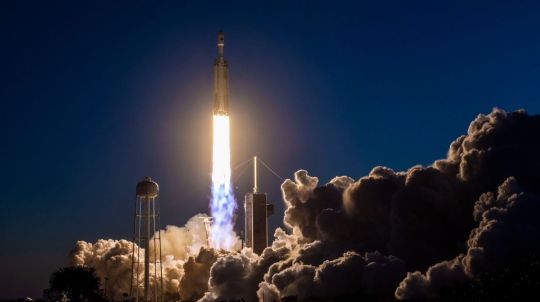
View On WordPress
#commercial communications satellite#Earth#Elon Musk#Falcon 9#Falcon Heavy#geostationary orbit#June 27#Jupiter 3#Kennedy Space Center#NASA#record-breaking mission#rocket#satellite#space#SpaceX#SpaceX Falcon
0 notes
Text
#Self-Defense Forces#SpaceX#Starlink#Satellite constellation#Trial basis#Japanese government sources#Communication capabilities#China#Russia#Attack satellites#High-speed communication service#U.S. space development company#U.S. military satellites#X-band communication satellites#Geostationary orbit#Private-sector satellite constellation#Ground-based jammers#Contingency#Operational issues#Military technology#National security#japan#tokyo#investment
0 notes
Note
hey um. what's geostationary orbit and why is it impossible for TAG's TB5 to achieve?
Hello!! I'm assuming you're coming in from the stack of memes I made lol so welcome welcome, this is my well-known pet peeve and I will happily explain because it involves my favourite subject - physics!
"Impossible to achieve" isn't quite accurate - my argument is formed purely on the observational evidence of where it is, such that when the show makes references to TB5 being in geostationary orbit it doesn't make sense because it's simply.... not.
So strap in, I'll go through this as clearly as I can but feel free to ask follow up questions :D Or just generally hang out lol TAG is a fun time despite the handwave-y physics ahaha :D
1. What is geostationary orbit?
Geostationary orbit is the specific orbit where a satellite/space station/whatever moves with the exact same period as the Earth's rotation i.e. 24 hours AND is placed so that the object is directly over the equator, it will move in that orbit at the same rate as the location it is over, so that it will always be over that position at all times. This gives it the name "geostationary", implying that the Earth doesn't move relative to the orbiting object, or if you look down you'll always see the same place.
Both conditions must be met for geostationary orbit to occur; an orbit with a greater or lower period will fall out of step with the Earth fairly quickly, and if not on the equator, you'll get a related type of orbit known as a geosynchronous orbit which will move up and down relative to the equator rather than staying put.
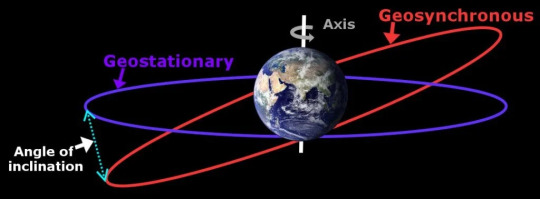
Furthermore, I won't take you through the calculation (1 | 2 | 3), but using Kepler's Third Law which is sufficiently accurate for this scenario, this orbit must always be ~36,000 km above the Earth, or the quoted 22,500 miles in the show. That is the main evidence in the show that implies that the writers intended for TB5 to be in geostationary orbit, like TOS was written to be.
However....
2. Why can't TB5 be in geostationary orbit?
It's not that it can't, it's that it isn't! There's two main reasons for this that I return to when grumbling about this to my friends (they are long-suffering on this point lol thank goodness they're reasonably good-humoured about it...)
Reason 1: The size of the Earth from TB5
This is the most damning evidence. Let's make some visual comparisons.
This is what the Earth looks like from the International Space Station which maintains an orbit about 400 km above the surface of the Earth (in a region known as Low Earth Orbit).
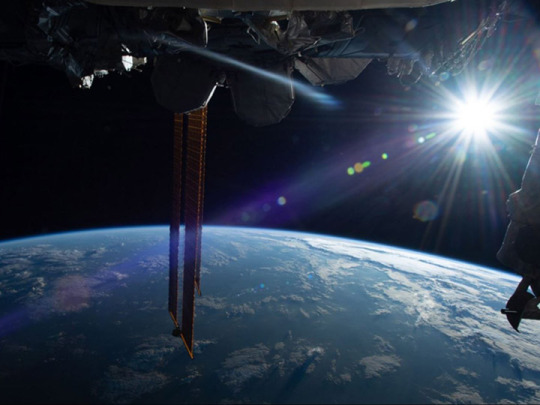
It's a little more complicated to show what Earth looks like from geostationary orbit as many satellites in this region are communication relays or broadcasting satellites (very appropriate for TB5 it must be said!!) But that being said, this is a full disk image of Earth from Japan's Himawari 5, a weather satellite in geostationary orbit.

Now take a look at the animation in TAG and decide for yourself what was being used as inspiration!

But I'm a physics nerd, so I won't take blind faith in some pictures! No, no - if there's a specific height that an orbit must maintain in order to remain in this orbit and the size of the Earth doesn't change, then it should follow that the Earth must be some kind of stable "apparent" size that we can figure out. Think about a freestanding house from 40 m away. It doesn't matter in which direction the 40m is, the house takes up the same space in our vision. The same follows here.
Once again, I'll gloss over the calculations ( 1 | 2 | 3) and simply state that from geostationary orbit, the Earth should take up no more than about 20° of our field of vision. In comparison the visual angle of the Moon is about 0.5° so it's still going to look really big!! But not as big as you'd see from the ISS :P If you make both hands into fists, place them next to each other and hold them at arms length from your body, that would be the approximately the width of the Earth from geostationary orbit.
So TB5?

....might be a wee bit closer than that 😂
Reason 2: The locations on Earth
This one's a little looser, but it illustrates my second point - in order to be geostationary, TB5 needs to..... stay over one location? Like okay sure it has rockets and engines so that it's able to move around, we've seen them plenty of times. But that doesn't change that fact that even when these are not in use, TB5 is never in one place.
Here's some examples…
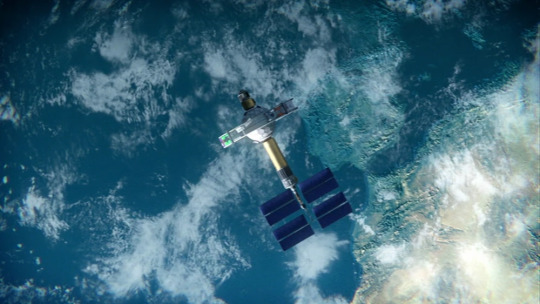
The Strait of Gibraltar (Spain and Morocco) | 1x07 (Runaway)

Looks like Japan in the background to me | 1x07 (Runaway)

Ireland and Great Britain | 1x08: EOS

Cheating a tad, but he's only just launched so it's reasonable to assume that here TB5 is over SE Asia | 2x02 (Ghost Ship)
None of these are examples where John's manoeuvred TB5 into position like he does in Skyhook (1x11) and Impact (2x09) so it's reasonable to assume that TB5 is following its assigned orbit... and its not geostationary!
Moral of the story: TB5 could be in geostationary orbit, there's nothing stopping it! But uh... it's not. Thanks for listening ;D
All images stolen either from the thunderbirds wiki, or I've attached a click through link to their origin :)
66 notes
·
View notes
Text
不協和音のわたしたち | cosmomule (feat. mekakushe)
#不協和音のわたしたち#Can't understand each other#cosmomule#mekakushe#静止軌道上空のあなたへ#to you on geostationary orbit#my post#musik
2 notes
·
View notes
Text
🆕 「 to you on geostationary orbit」 by cosmomule
Available for streaming worldwide!🌐
Added to our weekly playlist 🎧
https://spoti.fi/3lgjH73
0 notes
Text
Connecting the World: Telecommunications Satellites Enhance Global Communication Networks

In an increasingly interconnected world, the role of telecommunications has never been more critical. The rapid growth of digital communication technologies has significantly transformed the way we live, work, and interact with one another. At the heart of this transformation lies a technology that orbits high above us – telecommunications satellites. These sophisticated machines play a pivotal role in bridging gaps across continents, bringing people closer, and enabling the seamless exchange of information on a global scale.
Telecommunications satellites are the backbone of modern communication networks. These satellites are designed to transmit signals across vast distances, overcoming the limitations of terrestrial infrastructure. By relaying signals from one point on the Earth's surface to another, they enable instant communication, regardless of geographical barriers. This capability has revolutionized various sectors, from media broadcasting to internet services, emergency communications, and more.
The Evolution of Telecommunications Satellites
The journey of telecommunications satellites began in the mid-20th century. Early experiments with satellite communication laid the groundwork for what would become a global network. The launch of the first artificial satellite, Sputnik, in 1957 marked the dawn of the space age. However, it wasn't until the launch of the first geostationary satellite in 1965 that the true potential of satellite communication was realized. This satellite, positioned in a fixed location relative to the Earth's surface, could provide continuous coverage to a specific region, paving the way for real-time communication across the globe.
Since then, telecommunications satellites have evolved dramatically. Advances in technology have led to the development of more sophisticated satellites with greater capacity, reliability, and efficiency. Modern satellites are equipped with high-powered transponders, enabling them to handle large volumes of data transmission. These advancements have expanded the capabilities of satellite communication, making it an indispensable part of the global communication network.
How Telecommunications Satellites Work
The operation of telecommunications satellites is based on the principles of radio frequency transmission. These satellites receive signals from ground-based stations, amplify them, and retransmit them back to other ground stations. The process involves several key components:
Uplink: The transmission of signals from a ground station to the satellite. This is typically done using high-frequency radio waves.
Transponder: The component within the satellite that receives the uplink signal, amplifies it, and changes its frequency for retransmission.
Downlink: The transmission of signals from the satellite back to a ground station. This completes the communication loop, allowing the original signal to reach its intended destination.
Satellites are positioned in different orbits depending on their specific functions. Geostationary satellites, which orbit at approximately 35,786 kilometers above the equator, provide continuous coverage to specific regions. Low Earth orbit (LEO) satellites, positioned much closer to the Earth's surface, offer lower latency and are often used for services requiring real-time data transmission, such as internet connectivity.
Impact on Global Communication Networks
The impact of telecommunications satellites on global communication networks is profound. They have enabled a level of connectivity that was previously unimaginable, facilitating the seamless exchange of information across vast distances. Here are some key areas where their impact is most evident:
Media and Broadcasting
Telecommunications satellites have revolutionized the media and broadcasting industry. They enable the transmission of television and radio signals to remote and underserved areas, ensuring that people worldwide have access to information and entertainment. Live broadcasts of major events, such as sports competitions and political speeches, are made possible through satellite technology, allowing audiences to experience these moments in real time.
Internet Connectivity
In many parts of the world, terrestrial internet infrastructure is either insufficient or nonexistent. Telecommunications satellites provide a vital solution to this problem by offering internet connectivity to remote and rural areas. Satellite internet services have become increasingly popular, providing reliable and high-speed internet access to communities that were previously disconnected.
Emergency Communications
During natural disasters and emergencies, terrestrial communication networks are often disrupted. Telecommunications satellites play a crucial role in providing emergency communication services, ensuring that rescue and relief operations can be coordinated effectively. Satellite phones and portable satellite communication devices are essential tools for first responders and humanitarian organizations, enabling them to maintain communication in even the most challenging conditions.
Global Navigation Systems
Telecommunications satellites are also integral to global navigation systems. They provide the precise timing and positioning data required for navigation and location-based services. These systems are essential for various applications, including aviation, maritime, and land transportation, as well as for personal navigation devices used by millions of people worldwide.
Future Trends and Developments
The field of telecommunications satellites is continually evolving, driven by advancements in technology and increasing demand for connectivity. Several trends and developments are shaping the future of this industry:
High Throughput Satellites (HTS)
High throughput satellites represent a significant advancement in satellite technology. These satellites offer substantially increased data transmission capacity, enabling faster and more reliable communication services. HTS technology is particularly beneficial for providing broadband internet access to remote and underserved areas, helping to bridge the digital divide.
Constellations of LEO Satellites
One of the most exciting developments in satellite communication is the deployment of constellations of low Earth orbit satellites. These constellations consist of hundreds or even thousands of small satellites working together to provide global coverage. LEO constellations offer lower latency and higher data transfer rates compared to traditional geostationary satellites, making them ideal for applications such as internet of things (IoT) connectivity and real-time data services.
Advances in Satellite Manufacturing
Advances in satellite manufacturing are making it possible to produce smaller, more cost-effective satellites. These miniaturized satellites, often referred to as smallsats or cubesats, can be launched in large numbers, providing flexible and scalable communication solutions. The reduced cost of manufacturing and launching these satellites is driving innovation and enabling new players to enter the market.
Integration with Terrestrial Networks
The integration of satellite communication with terrestrial networks is another key trend. Hybrid networks that combine satellite and terrestrial technologies can offer seamless connectivity, ensuring that users have access to reliable communication services regardless of their location. This integration is particularly important for providing consistent internet coverage in areas with challenging terrain or sparse infrastructure.
Challenges and Considerations
While telecommunications satellites offer numerous benefits, there are also challenges and considerations to address. One of the primary challenges is the cost associated with launching and maintaining satellites. The development, launch, and operation of satellites require significant investment, which can be a barrier for some organizations.
Additionally, the increasing number of satellites in orbit raises concerns about space debris and collision risks. Ensuring the long-term sustainability of space activities requires careful management of satellite operations and the implementation of measures to mitigate the risk of space debris.
Conclusion
Telecommunications satellites have fundamentally transformed global communication networks, enabling instant connectivity and information exchange across vast distances. From media broadcasting and internet connectivity to emergency communications and global navigation, the impact of these satellites is far-reaching and profound.
As technology continues to advance, the future of telecommunications satellites looks promising. High throughput satellites, LEO constellations, and advancements in satellite manufacturing are set to further enhance the capabilities of satellite communication. By overcoming challenges and embracing innovation, telecommunications satellites will continue to play a crucial role in connecting the world, bridging gaps, and enabling a more connected and informed global community.
In a world where connectivity is essential, telecommunications satellites stand as a testament to human ingenuity and the relentless pursuit of progress. They embody the spirit of exploration and innovation, bringing people closer together and fostering a sense of global unity. As we look to the future, the continued evolution of telecommunications satellites promises to unlock new possibilities and drive the next wave of communication advancements.
196 notes
·
View notes
Text
Space Station Concepts: Space Operations Center
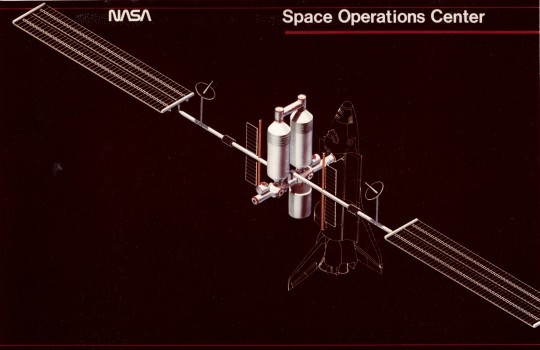

"The SOC is a self-contained orbital facility built up of several Shuttle-launched modules. With resupply, on-orbit refurbish- ment and orbit maintenance, it is capable of continuous operation for an indefinite period. In the nominal operational mode, the SOC is manned continuously, but unmanned operation is possible.

The present mission management and control process is characterized by a people-intensive ground monitoring and control operation involving large supporting ground information and control facilities and a highly- integrated ground-flight crew operation. In order to reduce dependence on Earth monitoring and control, the SOC would have to provide for increased systems monitoring; fault isolation and failure analysis, and the ability to store and call up extensive sets of data to support the onboard control of the vehicle; and the onboard capability for daily mission and other activity planning."
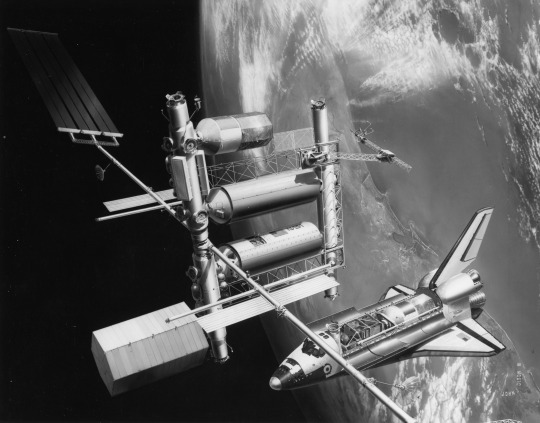

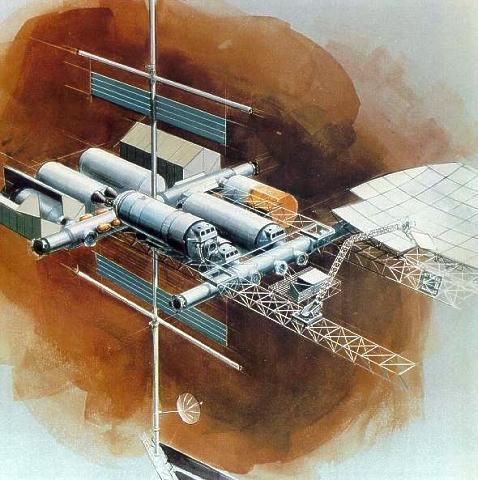
"Like most other space station studies from the mid/late 1970s its primary mission was the assembly and servicing of large spacecraft in Earth orbit -- not science. NASA/JSC signed a contract with Boeing in 1980 to further develop the design. Like most NASA space station plans, SOC would be assembled in orbit from modules launched on the Space Shuttle. The crew's tour of duty would have been 90 days. NASA originally estimated the total cost to be $2.7 billion, but the estimated cost had increased to $4.7 billion by 1981. SOC would have been operational by 1990.
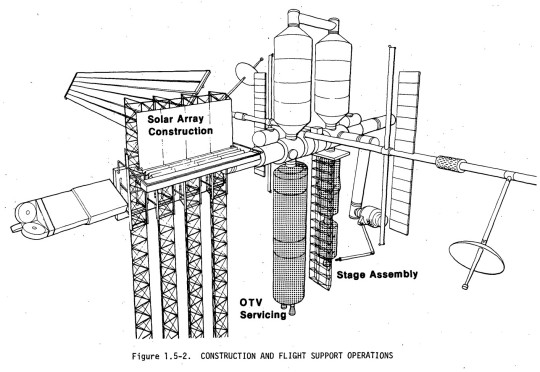
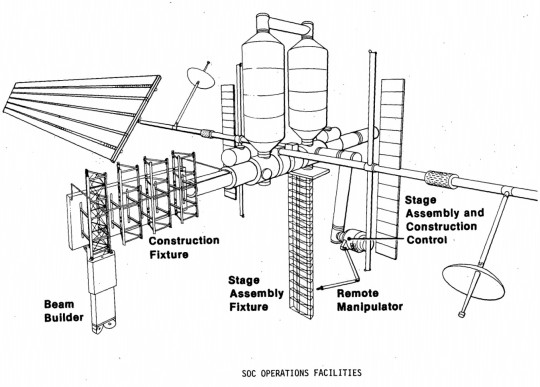

NASA's Johnson Spaceflight Center extended the Boeing contract in February 1982 to study a cheaper, modular, evolutionary approach to assembling the Space Operations Center. An initial power module would consist of solar arrays and radiators. The next launches would have delivered a space tug 'garage', two pressurized crew modules and a logistics module. The completed Space Operations Center also would have contained a satellite servicing and assembly facility and several laboratory modules. Even with this revised approach, however, the cost of the SOC program had grown to $9 billion. Another problem was Space Operations Center's primary mission: spacecraft assembly and servicing. The likely users (commercial satellite operators and telecommunications companies) were not really interested in the kind of large geostationary space platforms proposed by NASA. By 1983, the only enthusiastic users for NASA's space station plans were scientists working in the fields of microgravity research and life sciences. Their needs would dictate future space station design although NASA's 1984 station plans did incorporate a SOC-type spacecraft servicing facility as well."
Article by Marcus Lindroos, from astronautix.com: link

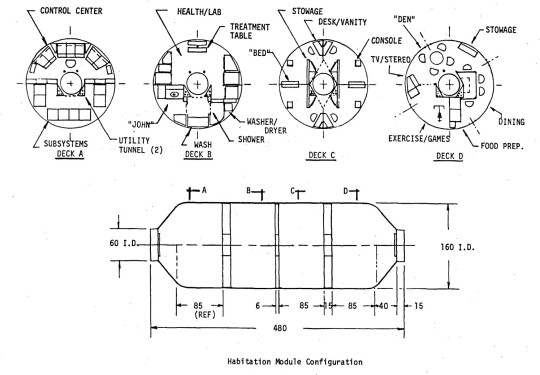


NASA ID: link, S79-10137
Boeing photo no. R-1859, link, link
#Space Operations Center#Space Station Freedom#Space Station Concept#Space Station#Concept Art#Space Station Program#Space#Earth#Space Shuttle#Orbiter#NASA#Space Shuttle Program#1979#1980s#my post
455 notes
·
View notes
Text

Comparing Ariane 6 variants' launch capabilities with animals
The Ariane 62 can lift 5000 kg (or an Asian elephant) to the geostationary transfer orbit, and the Ariane 64, 11 500 kg (or a whale shark), from where spacecraft boost themselves into geostationary orbit.
64 notes
·
View notes
Text
US authorities said they have issued a "breakthrough" first-ever fine over space debris, slapping a $150,000 penalty on a TV company that failed to properly dispose of a satellite.
On Monday the Federal Communications Commission (FCC) came down on Dish for "failure to properly deorbit" a satellite called EchoStar-7, in orbit since 2002.
"This marks a first in space debris enforcement by the Commission, which has stepped up its satellite policy efforts," the FCC, which authorizes space-based telecom services, said in a statement.
As the geostationary satellite came to the end of its operational life, Dish had moved it to an altitude lower than the two parties had agreed on, where it "could pose orbital debris concerns," the FCC said.
The commission said Dish, a US satellite television provider, pledged in 2012 to elevate the satellite to 300 kilometers (190 miles) above its operational arc.
But with fuel running low, it retired the satellite at an altitude just over 120 kilometers above the original arc.
Continue Reading
202 notes
·
View notes
Photo

Temple of Malice
"Mothership will maintain Earth geostationary orbit. All systems fully operational. Attack Squad Delta, prepare to enter transmat."
Artist: Jokubas Uogintas
TCG Player Link
Scryfall Link
EDHREC Link
82 notes
·
View notes
Note
wait Lew I have a space law question, how do we decide who gets to put satellites where? like I know there's thousands of satellites in low Earth orbit, how close can someone put a new satellite to old ones? how crowded is that situation? and there's a buncha scientific satellites (the only space thing I know something about) that are all in very similar orbits, who gets to add a satellite to that train? do people fight over spots?
good question! generally, there is a freedom of the exploration and use of outer space, so everyone can do what they want up there as long as they don't violate any other laws - and, as long as outer space remains "free for exploration and use by all States without discrimination of any kind, on a basis of equality and in accordance with international law" (Art I OST). now, what the fuck does that mean, i hear you ask, and to that i shrug and smile politely because we are still figuring that out. outer space is becoming increasingly congested, and it's use is certainly not equal - while the USA owns HALF of the satellites in space, there are many countries who have launched no objects yet, even though many critical infrastructures depend on the access to space. you see the problem.
fights over spots do happen, especially in GEO. this is the geostationary orbit, which is 35,786 km above the equator - satellites here orbit as fast as the earth turns and therefore remains over the same spot of the earth forever, which is crucial for telecommunication (imagine adjusting your satellite dish every minute to watch TV). and those spots are very coveted, as they are very, very limited. there have been multiple attempts of the UN to regulate this on an equitable basis, none of them successful (in my opinion).
equitable access to outer space remains a huge problem and inequalities on earth are often exacerbated in outer space - which is why we need national regulation that actually implements Art I OST instead of ignoring it! (looking at you, US of fucking A)
33 notes
·
View notes
Text
Dr. Stone chapter 2D trivia post
Spoilers ahead !
Check out too, my trivia post for the previous chapter.

This changes everything, folks! however, we gotta start from the start.

Chrome's drawn this roadmap, and he seems to pretend to build yet another of his silly storehouse towers like he's done around the globe. Next stop, the moon.



This confused me for a while until it was pointed out to me that "EMU" stands for Extravehicular Mobility unit; which is what we normally call a spacesuit (and I call and EVA suit), and notably it doesn't look muck like these simple, yet decidedly comfy and cute looking jumpsuits.


The graphic depicted below actually shows two trips, if you follow the arrows along the lines, you can see the black ones show a trip from earth orbit to the moon, and the white ones show the return trip, landing in the middle of what loosely resembles the pacific ocean, east of Japan.

In other news, Suika joins the tradition of the space elevator, an idea that has been itching in the back of people's minds since the 1890's

The more detailed explanation of this is a bit more lenghty but I'll keep it simple, so buckle up.
The idea of a space elevator is that a weight with a cable tethering to earth, could keep it tense if the weight is moving too fast (so much so that if let loose it would escape into space, or at least a higher orbit).
This cable can support a vehicle going up along it, bringing any cargo within it to space, using much less energy and resources than a rocket.
How to make a cable that can support its own weight over such a huge distance is the main reason we haven't built one.

A problem that arises from this, is that if the weight doesn't match the rotation of the earth, the cable would get pulled around (eventually breaking or winding around the earth, pulling the weight down, as cartoony as that is), so we need it to hover over one spot.
Now we gotta talk about geostationary orbit, to make this easier.
So, when something is orbiting the earth, it needs to move really fast to combat gravity in such a way that the earth curves away from the object at the same rate it's falling towards it (spaceflight really is the art of falling to the ground and missing it, as the saying goes.)
The farther out you go, the weaker gravity's pull gets, and the slower the satellite needs to be in order to find this balance. Eventually it reaches the point where, if its flying around the equator, it will, at one point, match the speed of the ground spinning beneath, this is at 35786 km above.
Such a satellite appears still in the sky, which is very handy to, as a sidenote, aim a small TV dish at it, and just leave it in place, as you may have at home.
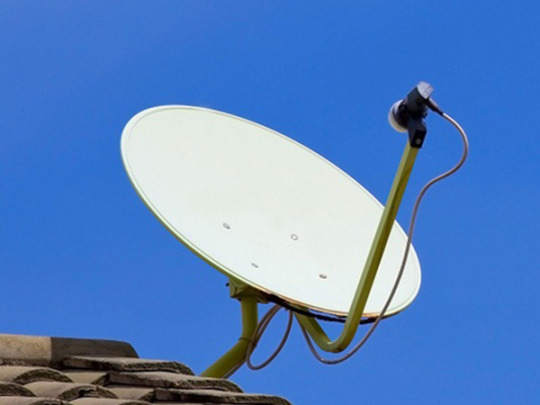
However one must notice that in a space elevator, the satellite (our weight) is not only pulled by gravity but also by the tension in the cable.
Since it's pulled in with a greater force, it falls faster than a normal satellite, and so it needs to also travel faster to avoid falling back to earth.
As a result, it also needs to be further away than a geostat satellite, so it needs to travel a longer way around the earth, and again find the balance of speed with rotation, staying still in one spot while keeping the cable taut.
This is why the weight is shown beyond geostationary orbit here. Yes, this was a long winded explanation for just that.

And after all that, here we all are, ignoring the fact that suddenly petrified hair is flexible.

Perhaps it's like glass fiber / glass wool, and it can be flexible when it's thin enough (yes, glass fiber is just glass but thin, if you weren't aware. Incidentally, most glass fiber is made by a process that works the same as a cotton candy machine... wait this was already shown in Dr. Stone, fu-).
This however doesn't explain how this flexibility hasn't been observed in statues before. Maybe her hair is special after all.

Also special is spider silk, although sometimes overhyped by the media. Spider silk has some outstanding mechanical properties, it's very durable, and it can take a lot of tension and deformation before breaking.


Ruri here makes a reference to her previously stated occupation after the main series. A lot of people took issue with the aftermath of the characters in general, myself included. Still mad at Kohaku joining the police, I'm pretending that didn't happen.

This might be an autism 100 take, but the wheels in this cart are backwards. The flanges should be on the inside, and the taper should be towards the outside.
This geometry helps railway wheels stay on the track, go around bends, and not have to constantly abuse the flanges to not fall off the rails.
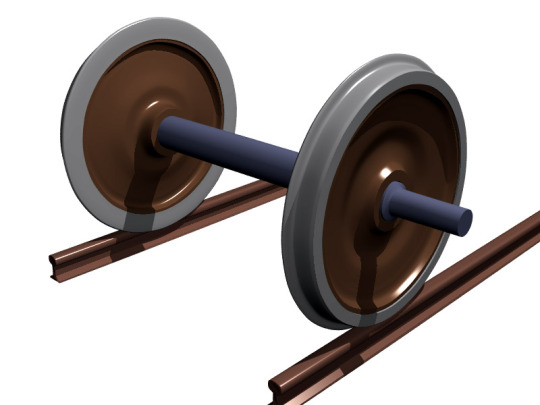

The silk road... I really am just googling basic things for you, am I?
It was an ancient trade route network joining asia with the middle east and europe. Silk was one of the most famous products traded through the network.
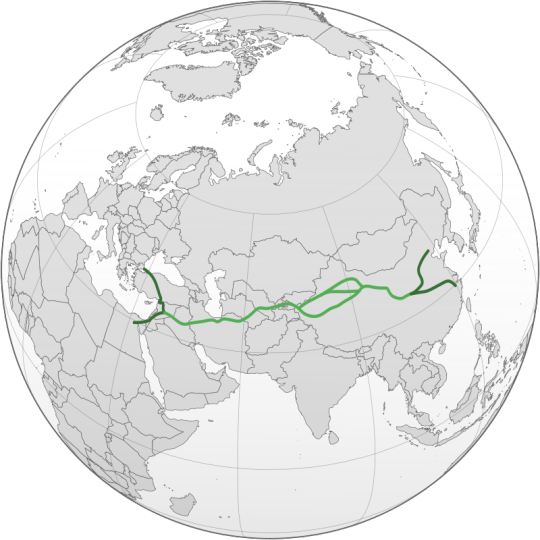
yeesh, I've been typing this for ages (tumblr logged me out while I was writing this post and lost like half of it), and I haven't even gotten to talk about induction motors yet.

A linear motor is just an electric motor that rather than making something spin, it pulls itself along some sort of guide rail. These are in use in some trains but they are not common, the infrastructure cost is much higher than a normal railway.
Why am I talking about trains again...
One way to make it work is by induction.

The tl:dr is that when a magnetic field is moving through a conductive object, it can effectively drag it with it to an extent.
The reason this happens is called Lenz's law; the variation of the magnetic field through the metal causes an electric current to flow through it.
This current, just like an electromagnet you may have put together in science class, produces it's own magnetic field that interacts with the one coming from outside, hence making the metal react, but only when the field is moving or otherwise changing.
A big advantage is that there needs to be no contact between the source of the field and the moving metal; this is used in all sorts of electric motors even in homes, you'll find them in fans, refrigerators and washing machines, etc.

The train/motor would have a magnetic field underneath with a north-south-north-south-... pattern, which flows towards the back like a river (made by a lot of electromagnets switching in coordination).
As the magnetic river flows backwards, the induced currents in the rail produce their own magnetic field in opposition, pushing the train forward.
How viable is it to use this on a thin cable that needs to pull itself up is another story, and I have my doubts. The electronics involved would be really complex, costly and perhaps even unwieldy, but at least the conductive cable can also be used to deliver power to the elevator with some tweaks.

The structure they begin constructing for the full size elevator is named after the 1979 novel "The fountains of Paradise" by Arthur C. Clarke, in which a space elevator is also constructed.


So, we've made it to this part. As far as I've seen this one panel has been the focus of like 50% of the discussion regarding this chapter.

We all see what he's doing whether we acknowledge it or not; Inagaki should know that you cannot build a relationship on just standing close and gazing with passion; believe me I checked, multiple times.
Wouldn't mind if he hadn't procrastinated on developing Senku's side, the girl has wanted her vegetables since day two (but not day one)



And now, things get really messy, as some mind boggling events lead Ryusui to ask "why, man?"
Look, I've already added 30 images to this post, and I imagine you have seen how this chapter ends, if you haven't, buddy what the heck are you doing here.
Have some emoji, I'm not gonna make a second post about this.
🥨✨🦟 ⁉️👱🏼♂️🏴☠️ 👨🚀☠️??
You may be confused, you should.
But after a while I came to a conclusion that I feel is pretty solid, and you may have seen it in the post from earlier.
To summarize:
Ryusui noted that things were going suspiciously well for them, and the sudden disappearance of mosquitoes in the Kanto region ticked him off to something.
He sent people to search and indeed found that mosquitos have been petrified within the region, and questions whyman about it, going as far as accusing them of pretending to be Byakuya from the future.
That's where we are left.
The medusa is fully capable of faking the signal they received from "Byakuya". The receiver only detected bursts of petrification beam presumed to be from the future and decoded them as morse code, and it was noted by Balb on discord that if you trace a circle with the center near Tokyo (where the lab keeping whyman is) and a radius reaching as far as Fuji, where they received the message, the circle covers the majority of the Kanto region as stated.
The bursts of petrification would have been invisible to humans, as only the affected species can see them.
So it is assumed that the mosquitos were petrified as a means for whyman to send the fake signal all the way to Fuji, depleting its diamond battery in the process.
However I believe it's also possible the mosquitos were zapped later to make work easier for the people building the space elevator as noted by Kaseki.
Several months if not more must have passed since the Byakuya message and whyman being caught (enough for Kohaku's hair to regrow), and it would be odd that no one would have noticed the lack of mosquitos, their petrified bodies, or the effect their absense would have in the ecosystem.
So why do any or all of this?
Well we know what whyman is largely motivated by, its survival and the spread of its kind across the universe.
So I think it's trying to accelerate human progress for that purpose, so we eventually get to the point where more medusas can be made, or who knows, maybe even succeed in warning the past ones with the time machine.
I also think it's likely this misunderstanding is gonna fizzle out once some dialog is made and Senku basically says yes to that goal too.
Will we get a triple twist and find that the Byakuya message was real after all, and the mosquitos were a separate event?
Will the sengen and kohasen crowds envelop the world in thermonuclear hellfire?
And will this be the true final end of Dr. Stone? hard to tell, but the answers may come next week.
Goodnight.
#dr. stone trivia#4D Science#dcst#Dr. Stone 2D#dr stone#dr. stone#drstone#dcst senku#byakuya ishigami#dr stone senku#senku dr stone#senku ishigami#dcst kohaku#dr stone kohaku#kohaku dr stone#dcst suika#dr stone suika#suika dr stone#dcst gen#dr stone gen#gen dr stone#dcst chrome#dr stone chrome#chrome dr stone#dcst kaseki#dr stone kaseki#kaseki dr stone#dcst ryusui#dr stone ryusui#ryusui dr stone
55 notes
·
View notes
Photo

NASA spots unexpected X-shaped structures in Earth's upper atmosphere — and scientists are struggling to explain them | Live Science
A NASA satellite has spotted unexpected X- and C-shaped structures in Earth’s ionosphere, the layer of electrified gas in the planet’s atmosphere that allows radio signals to travel over long distances.
The ionosphere is an electrified region of Earth's atmosphere that exists because radiation from the sun strikes the atmosphere. Its density increases during the day as its molecules become electrically charged. That's because sunlight causes electrons to break off of atoms and molecules, creating plasma that enables radio signals to travel over long distances. The ionosphere’s density then falls at night — and that's where GOLD comes in.
NASA's Global-scale Observations of the Limb and Disk (GOLD) mission is a geostationary satellite that has been measuring densities and temperatures in Earth's ionosphere since its launch in October 2018. From its geostationary orbit above the western hemisphere, GOLD was recently studying two dense crests of particles in the ionosphere, located north and south of the equator. As night falls, low-density bubbles appear within these crests that can interfere with radio and GPS signals. However, it's not just the wax and wane of sunshine that affects the ionosphere — the atmospheric layer is also sensitive to solar storms and huge volcanic eruptions, after which the crests can merge to form an X shape.
In its new observations, GOLD found some of these familiar X shapes in the ionosphere — even though there weren't any kinds of solar or volcanic disturbances to create them. ...
... In addition to the odd X's, GOLD also saw curved C-shaped bubbles appear in the plasma surprisingly close together. Scientists think they are shaped and orientated according to the direction of winds, but GOLD imaged C-shape and reverse-C-shaped bubbles as close as about 400 miles (643 kilometers) apart. To have wind patterns change so drastically over such short distances is quite unusual, according to the researchers. ...
17 notes
·
View notes
Text

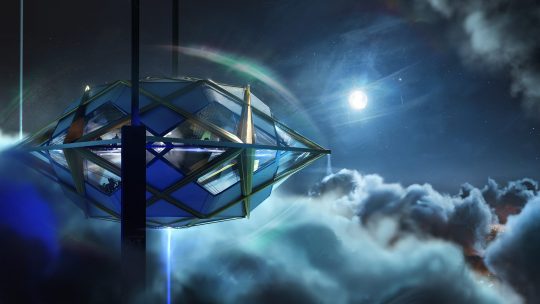
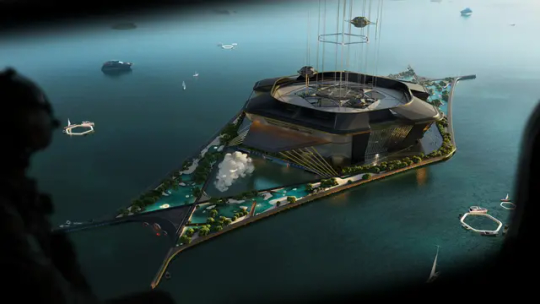






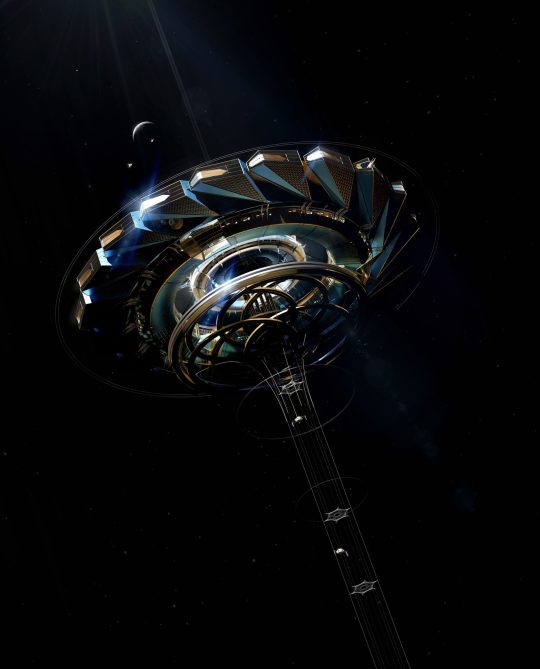
Jordan-William Hughes's 'Project Ascensio' Space Elevator
The concept is for an asteroid in geostationary orbit to serve as the counterweight for this spaceport. The elevator will be connected to the ocean through a robust tether that will transport it from the asteroid to Earth.
Drones will be able to go up and down the tether and be able to transport both cargo and people. The idea is for the space station to be more than 26,000 kilometers above Earth and then the spaceport here on our planet to be at sea-level.
#art#design#stairwell#stairway#lift#elevator#space#ascensio#meteorite#jordan willial hughes#concept#render#sci-fi#space travel#spaceport#drones#tether
44 notes
·
View notes
Text
静止軌道上空のあなたへ | cosmomule
#cosmomule#静止軌道上空のあなたへ#to you on geostationary orbit#my post#musik#one of the best things ive heard in a while#cosmomules EPs are incredible along with everything else he's been a part of
2 notes
·
View notes